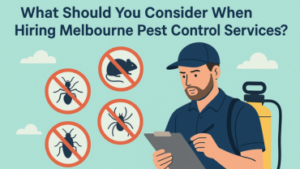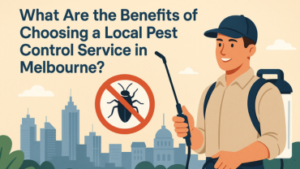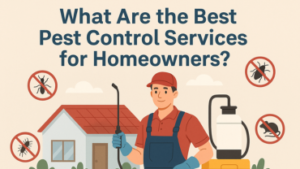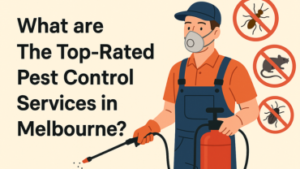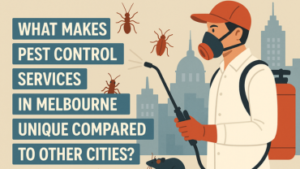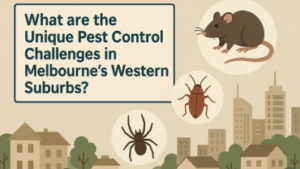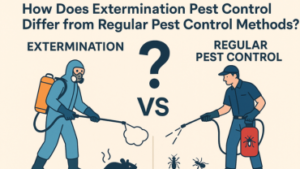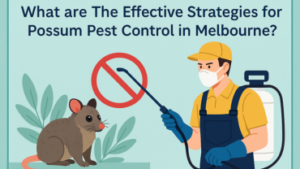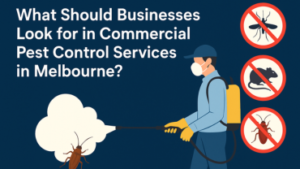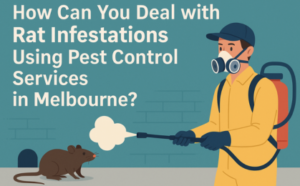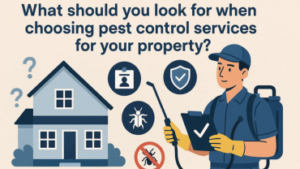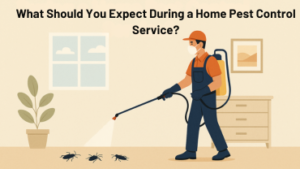What should you look for when choosing control pest services for your property?
There’s nothing quite like the sinking feeling of spotting a cockroach scuttle across your kitchen counter or hearing mysterious scratches in the walls at 2 AM. Pests have a way of turning homes into their personal playgrounds, and once they move in, they’re terrible at taking hints to leave.
But here’s the catch: not all pest control companies are created equal. Some cut corners. Others use outdated methods. And a few might even leave you with more problems than you started with. So, how do you separate the real pros from the fly-by-night operators?
This guide will walk you through exactly what to look for, and what to avoid, when choosing pest control services in Australia. Because your home shouldn’t be a free-for-all buffet for six-legged (or furry) freeloaders. Let’s take back control.
Why Professional Pest Control Services Matter
Pests aren’t just annoying; they can damage your property and even pose health risks. DIY solutions might offer temporary relief, but professional pest control services provide long-term protection. Experts have the right tools, knowledge, and treatments to eliminate pests effectively while ensuring safety for your family and pets.
Choosing Your Pest Control Partner
When evaluating pest control services, it’s essential to distinguish between competent professionals and substandard operators. The right provider should demonstrate:
1. Demonstrated Expertise
- Proven experience handling your specific pest issue (termite specialists differ from general pest technicians)
- Technical knowledge of pest biology and behaviour (effective control requires understanding nesting habits and life cycles)
- Advanced methodologies beyond basic spraying (such as thermal treatments or baiting systems for rodents)
Recommendation: Inquire about their most challenging cases and resolution strategies.
2. Regulatory Compliance
- Current licensing as mandated by state regulations
- Chemical accreditation demonstrating proper handling of restricted pesticides
- Public liability insurance covering potential property damage
Critical Check: Verify credentials through your state’s pest management licensing board.
3. Treatment Safety & Environmental Responsibility
- Low-toxicity formulations that target pests while minimising ecological impact
- Integrated Pest Management (IPM) approaches combining mechanical, biological, and chemical controls
- Transparent disclosure of all substances being applied
Note: Leading providers now utilise pheromone disruption and insect growth regulators as alternatives to broad-spectrum insecticides.
4. Customised Service Protocols
- Site-specific assessments before proposing solutions
- Tailored treatment plans addressing root causes rather than symptoms
- Clear documentation of service scope and expected outcomes
Warning Sign: Standardised pricing without property evaluation indicates inadequate service.
5. Verified Performance History
- Detailed client testimonials referencing specific pest scenarios
- Before-and-after case studies demonstrating measurable results
- Industry recognition or association memberships
Due Diligence: Cross-reference reviews across multiple platforms for consistency.
The Professional Standard
-
Technical proficiency in current control methodologies
Regulatory adherence ensuring legal and safe operations
Customised solutions based on scientific pest management principles
Common Pest Problems in Australian Homes
Think your home is just for you? Think again. Australia’s perfect storm of sun, humidity, and urban sprawl has created a VIP guest list for every property, except these “guests” don’t pay rent, they wreck it. Let’s meet the usual suspects:
Termites: The Stealthy Property Hackers
These white-collar criminals don’t break in, they eat in. Silent. Organised. Relentless. By the time you spot winged “swarmers,” they’ve likely been throwing a wood-feast rager inside your walls for months.
Defence Strategy: Annual professional inspections are like cybersecurity for your house, skip them, and you risk a (very expensive) system crash.
Cockroaches: The Disgusting Kitchen Squatters
Found one German cockroach? Congrats, you’ve got hundreds of its cousins playing hide-and-seek in your appliances. These disease-spreading ninjas:
- Thrive in takeout containers
- Trigger asthma in kids
- Can survive a nuclear blast (okay, not really—but they might as well)
Eviction Notice: Gel baits + crack-and-crevice targeting = the only way to break their lease.
Rodents: The All-Night Renovators You Didn’t Hire
Mice and rats are the worst kind of tenants:
- Chew through wiring (DIY electrical work, anyone?)
- Contaminate food with urine trails
- Multiply faster than TikTok trends
Pro Tip: That faint scratching in your ceiling at 3 AM? That’s not “the house settling”—it’s a rodent rave.
Spiders: The Roommates Who Bring Venom to the Party
Most Aussie spiders are harmless pest controllers… except for the deadly few. Redbacks love your outdoor furniture. Funnel-webs adore damp shoes. And huntsmen? They’re basically eight-legged cab drivers, startling but (usually) harmless.
Critical Intel: Professional removal is non-negotiable for dangerous species, no “she’ll be right” with these bite lodgers.
How Often Should You Schedule Pest Control Services?
Australia’s unique climate creates year-round pest pressures, but smart scheduling can keep infestations at bay. For most urban homes, we recommend:
- Quarterly treatments (every 3 months) for general pest prevention – ideal for stopping ants, cockroaches and spiders before they establish colonies
- Bi-annual termite inspections (before & after summer) when these silent destroyers are most active
- Monthly monitoring if you’re in bushfire recovery zones or near waterways where rodent populations fluctuate
Seasonal priorities change:
- Spring: Target wasp nests and emerging termite swarms
- Summer: Focus on flies, mosquitoes and pantry moths
- Autumn: Rodent-proof before winter shelter-seeking begins
- Winter: Ideal time for preventative barrier sprays
Pro Tip: High-risk homes (older weatherboards, bushland properties) may need monthly services during peak seasons.
What to Expect During a Professional Pest Inspection
A proper inspection should feel like a health check for your property. Here’s how quality pest control services operate:
Phase 1: The 360° Assessment (45-90 minutes)
- Technicians will examine every room, checking:
- Dark voids (under sinks, behind appliances)
- Roof cavities and subfloor areas
- External perimeter and garden beds
- They’re hunting for:
- Live pests and eggs
- Frass (termite droppings)
- Mudding trails
- Entry points and moisture issues
Phase 2: The Digital Report
- Thermal imaging of wall cavities
- Moisture meter readings
- Annotated diagrams showing risk zones
- Video evidence of any infestations
Phase 3: The Treatment Plan
- Immediate actions vs long-term prevention
- Chemical vs non-chemical options
- Safety protocols for pets/kids
- Follow-up schedule
7 Warning Signs You Need Pest Control ASAP
Don’t wait until you’re sharing your cereal with cockroaches. These red flags demand immediate action:
- The Midnight Scratching: Rodents in walls or roof spaces often sound like faint scratching after dark. One mouse can become 50 in months.
- Mysterious Bites or Rashes: Bed bugs and fleas leave clustered bites, often in straight lines. These won’t resolve without professional treatment.
- Sawdust-Like Residue: Termite “frass” appears like tiny wood pellets. Finding it means they’re already dining on your structure.
- Disappearing Pet Food: If Pup’s kibble vanishes overnight, you likely have rats or possums helping themselves.
- Crunchy Carpet Edges: Carpet beetles leave behind shed skins near skirting boards – their larvae destroy natural fibres.
- Flying Termites After Rain: Swarmers emerging indoors means an established colony exists within your walls.
- Grease Trails Along Walls: Cockroaches leave dark smears along their regular pathways, both a sign and health hazard.
The Bottom Line: If you notice even one of these signs, call professionals immediately. Most pests reproduce exponentially – today’s nuisance is tomorrow’s full-blown infestation.
Pest-Proofing Your Home: Long-Term Prevention That Actually Works
Let’s face it, no one wants to wage an endless war against pests. The real secret? Making your home so unappealing that bugs and rodents don’t even think about moving in. Forget quick fixes; these long-term strategies will turn your property into a fortress against unwanted invaders.
1. Seal the Deal—Literally
- Check doors and windows: Install weather stripping and repair torn screens.
- Seal cracks in walls and foundations: Use silicone caulk for small gaps, steel wool for larger ones (rodents can’t chew through it).
- Cover vents and chimneys: Fine mesh screens keep pests out while allowing airflow.
2. Eliminate the Free Buffet
- Store dry goods in airtight containers (those flimsy cereal bags might as well be welcome signs)
- Never leave pet food out overnight—rodents and cockroaches work the night shift
- Wipe counters and sweep floors daily (yes, even that one cracker crumb under the table counts)
3. Declutter & Deny Hiding Spots
- Replace cardboard boxes with plastic bins (roaches love the glue in cardboard, it’s like pest cocaine)
- Organise storage areas (that jumbled closet is a five-star hotel for mice)
- Vacuum under furniture regularly (dust bunnies = real bunny food for pests)
4. Smart Landscaping = Fewer Pests
- Keep plants away from the foundation: A 30cm gap prevents pests from using them as a bridge.
- Choose pest-resistant plants: Lavender, mint, and marigolds naturally repel insects.
- Avoid overwatering: Standing water breeds mosquitoes and attracts thirsty pests.
5. Schedule Regular Maintenance
- Annual termite inspections (non-negotiable in Australia!)
- Seasonal pest sprays (especially before summer hits)
- Routine checks for droppings, nests, or unusual noises
5 Essential Questions to Ask Your Pest Control Company (Before They Start Spraying)
- “What’s your game plan for my specific pest problem?”
- “How do you keep my family and pets safe during treatment?”
- “What happens if the bugs come marching back?”
- “What can I do to prevent future infestations?”
- “Can you show me proof you’ve solved problems like mine?”
Why Chris Pest Control Stands Out
At Chris Pest Control, we understand how stressful pest infestations can be. Our team of licensed experts provides safe, effective, and tailored pest control services across Australia. We use the latest techniques to ensure your home stays pest-free without compromising safety.
Our Approach to Pest Control
- Thorough Inspections: We identify the root cause of infestations.
- Custom Solutions: No generic sprays, only targeted treatments.
- Eco-Friendly Options: Safe for your family and the planet.
- Guaranteed Results: We don’t just eliminate pests; we prevent them from coming back.
Don’t Let Pests Take Over – Act Now!
Ignoring a pest problem only makes it worse. Whether you’re dealing with ants, termites, or rodents, professional pest control services are your best defence.
Ready to Reclaim Your Home?
Don’t wait until pests cause irreversible damage. Chris Pest Control is here to help with fast, reliable, and affordable solutions. Contact us today for a free inspection and let’s keep your property pest-free for good!
By following this guide, you’ll be able to choose the best pest control services with confidence. Remember, the right provider makes all the difference, so don’t settle for anything less than expert care.
Call Chris Pest Control now and say goodbye to pests for good!

